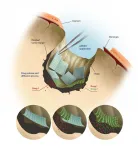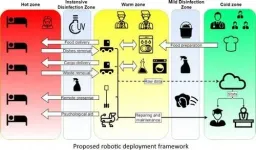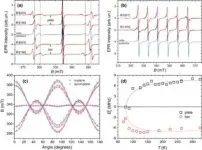(Press-News.org) Up to 25 percent of global food production is lost annually due to insects, primarily beetles. For the past 500 million years, beetles have successfully spread and adapted to life around the globe and now account for one of every five animal species on Earth. Yet as far back as ancient Egypt, these tough little bugs have invaded granaries and vexed us humans by destroying our crops.
As a result, food production and an abundant use of pesticides now go hand in hand. A large share of these pesticides damage biodiversity, the environment and human health. As various pesticides are phased out, new solutions are required to target and eradicate pests without harming humans or beneficial insects like bees.
This is precisely what researchers from the University of Copenhagen's Department of Biology are working on. As part of a broader effort to develop more "ecological" methods of combatting harmful insects in the near future, researchers have discovered which hormones regulate urine formation in the kidneys of beetles.
"Knowing which hormones regulate urine formation opens up the development of compounds similar to beetle hormones that, for example, can cause beetles to form so much urine that they die of dehydration," explains Associate Professor Kenneth Veland Halberg of the University of Copenhagen's Department of Biology. He adds:
"While it may seem a slightly vicious, there's nothing new in us trying to vanquish pests that destroy food production. We're simply trying to do it in a smarter, more targeted manner that takes the surrounding environment into greater account than traditional pesticides."
Ancient Egyptians weakened beetles' water balance using stones
The new study, as well as a previous study, also conducted by Kenneth Veland Halberg, demonstrates that beetles solve the task of regulating their water and salt balance in a fundamentally different way than other insects. This difference in insect biology is an important detail when seeking to combat certain species while leaving their neighbors alone.
"Today's insecticides go in and paralyze an insect's nervous system. The problem with this approach is that insect nervous systems are quite similar across species. Using these insecticides leads to the killing of bees and other beneficial field insects, and harms other living organisms," explains Kenneth Veland Halberg.
The centrality to survival of the carefully controlled water balance of beetles is no secret. In fact, ancient Egyptians already knew to mix pebbles in grain stores to fight these pests. Stones scratched away the waxy outer layer of beetles' exoskeletons which serves to minimize fluid evaporation.
"Never mind that they chipped an occasional tooth on the pebbles, the Egyptians could see that the scratches killed some of the beetles due to the fluid loss caused by damage to the waxy layer. However, they lacked the physiological knowledge that we have now," says Kenneth Veland Halberg.
One-hundred billion dollars of pesticides used worldwide
Pesticides have replaced pebbles. And, their global use is now valued at roughly 100 billion dollars annually. But as rules for pesticide use become stricter, farmers are left with fewer options to fight pests.
"The incentive to develop compounds which target and eradicate pests is huge. Food production is critically dependent on pesticides. In Europe alone, it is estimated that food production would decline by 50 percent without pesticide use. With just a single, more targeted product on the market, there would almost immediately be immense gains for both wildlife and humans," states Kenneth Veland Halberg.
But the development of new compounds to combat beetles requires, among other things, that chemists design a new molecule that resembles beetle hormones. At the same time, this compound must be able to enter beetles, either through their exoskeletons or by their feeding upon it.
"Understanding urine formation in beetles is an important step in developing more targeted and environmentally-friendly pest controls for the future. We are now in the process of involving protein chemistry specialists who can help us design an artificial insect hormone. But there is still a fair bit of work ahead before any new form of pest control sees the light of day," concludes Associate Professor Kenneth Veland Halberg.
Facts:
The study demonstrates that beetles regulate their kidney function in a fundamentally different way than all other insects. These differences can potentially be exploited to fatally disrupt the fluid balance of beetles without impacting other insects.
The research data reports that this unique kidney function evolved about 240 million years ago, and that the mechanism has played a significant role in the extraordinary evolutionary triumph of beetles.
Roughly one in five known animal species on Earth is a beetle. While 400,000 species have been described, there are thought to be well over one million beetle species in all.
Researchers used the red flour beetle (Tribolium castaneum) as a test species for the study because it has a well-sequenced genome that allows for the deployment of a wide spectrum of genetic and molecular biology tools.
The researchers got the beetle to urinate by injecting a hormone that scientists now know regulates urine formation in beetles.
Wheat weevils, confused flour beetles, Colorado potato beetles and other types of beetles and insects make their ways into up to 25 percent of the global food supply every year.
The problem is especially evident in developing countries, where access to effective pest control is limited or nonexistent.
The project was conducted in collaboration with researchers from the University of Edinburgh, Scotland and McMaster University, Canada
The study has just been published in the scientific journal PNAS https://doi.org/10.1073/pnas.2023314118
INFORMATION:
Atlantic bluefin tuna have returned to UK waters and can once again be seen during the summer and autumn months.
Their numbers appear to be increasing, following a long period of absence linked to population decline, according to research led by Cefas and the University of Exeter.
Marine scientists in the UK and Ireland have analysed multiple datasets, spanning a 16-year period, to document the increase in bluefin, which arrive into the waters of the Celtic Seas and off South West England, the Scilly Isles, and North West Ireland to feed in late summer and autumn.
The research is part of the Defra-funded "Thunnus UK" research project. ...
Stroke risk for patients with traumatic brain injuries is at its highest in the four months following injury and remains significant for up to five years post-injury, finds a new systematic review led by a team at the University of Birmingham.
Traumatic brain injury (TBI) is a global health problem affecting over 60 million people a year worldwide. Incidences of TBI are rising due to a range of factors including increased falls in the elderly, military conflict, sports injuries and road traffic accidents. However, advances in critical care and imaging have led to a reduction in TBI-related mortality.
Previous studies have associated TBI with a long-term risk of neurological diseases including dementia, ...
There are many variants of "goblet cells" in the intestines and they seem to have different functions, according to a new study from the University of Gothenburg. The study indicates that defects in goblet cells of a particular type may be a factor contributing to ulcerative colitis, an inflammatory bowel disease.
The entire inside of our intestines is covered by a thin layer of mucus that protects the fragile mucous membrane (mucosa) from bacteria and other microorganisms. If the microorganisms repeatedly come into contact with the intestinal mucosa, inflammation and even cell changes may result. These increase the risk of intestinal cancer. In a healthy colon, the mucus layer is up to a millimeter ...
Genova (Italy), 16th April 2021 - A micro-sized polymeric net wrapping around brain tumors, just like a fishing net around a shoal of fish: this is the microMESH, a new nanomedicine device capable to conform around the surface of tumor masses and efficiently deliver drugs. It has been described by the researchers of the IIT - Istituto Italiano di Tecnologia (Italian Institute of Technology) in Nature Nanotechnology. The new biomedical implant has been validated in preclinical studies that demonstrate its effectiveness for the treatment of glioblastoma multiforme.
This work has been carried out by the group of Prof. Paolo Decuzzi, head of the IIT Laboratory of Nanotechnology ...
The prevalence of intellectual disabilities, which means difficulties with learning and understanding new things, is roughly 1-2% in the population. People with a severe intellectual disability need help from others in daily activities throughout their lives.
Such disabilities can be caused by genetic changes or external factors. According to estimates, roughly 2,500 genes underlie intellectual disability, of which approximately half remain unidentified.
In recent years, the diagnostics for intellectual disabilities have improved thanks to advancements in techniques that make it possible ...
Language is one of the most notable abilities humans have. It allows us to express complex meanings and transmit knowledge from generation to generation. An important question in human biology is how this ability ended up being developed, and researchers from the universities of Barcelona, Cologne and Tokyo have treated this issue in a recent article.
Published in the journal Trends in Cognitive Sciences, the article counts on the participation of the experts from the Institute of Complex Systems of the UB (UBICS) Thomas O'Rourke and Pedro Tiago Martins, led by Cedric Boeckx, ICREA research professor at the Faculty of Philology ...
In December 2019, a new viral infection was detected in Wuhan, China. On January 30, 2020, the World Health Organization declared the outbreak a public health emergency of international concern, and on March 11, the COVID-19 pandemic. In light of the danger that the infection poses to human personnel, the idea to utilize automation in hospitals is one of the natural solutions in healthcare.
Among the paper's five co-authors, four are working in robotics and one is an expert in medicine. The paper presents a new concept of an infectious hospital that may become a worldwide standard in the future. The idea of this appeared while the authors ...
While studying strontium titanate with electron paramagnetic resonance, a team from KFU's Center for Quantum Technology has found that the shape of a specimen of strontium titanate influences its internal symmetry. The research was co-conducted by the Ioffe Institute of Physics and Technology (Russia) and the Institute of Physics of the Czech Academy of Sciences.
At room temperature, SrTiO3 is a crystal with high cubic symmetry, that is, the lattice of strontium titanate, like bricks, is composed of unit cells, each of which is a regular cube. However, the researchers showed the picture is a bit more nuanced. In ...
The research is conducted by Kazan University's Open Lab Gene and Cell Technologies (Center for Precision and Regenerative Medicine, Institute of Fundamental Medicine and Biology) and Republic Clinical Hospital of Kazan. Lead Research Associate Yana Mukhamedshina serves as project head.
Spinal cord injury mechanisms include primary and secondary injury factors. Primary injury is mechanical damage to the nervous tissue and vasculature with immediate cell death and hemorrhage. Secondary damage leads to significant destructive changes in the nervous tissue due to the development of excitotoxicity, death ...
The project was kickstarted in 2017 when a delegation of YTC America (subsidiary of Yazaki Corporation) visited Kazan Federal University. During the talks, YTC suggested that KFU participate in developing effective methods of separating single-wall carbon nanotubes (SWCNTs) into metallic and semiconducting specimens. This was to be done on Tuball tubes produced by OCSiAl, since they are the only ones currently available in industrial quantities.
Carbon nanotubes (CNT) is a family of 1D nanostructures with numerous verified applications, made possible due to their ...






